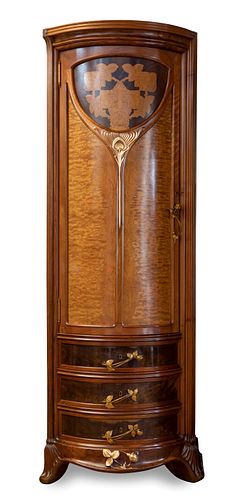JOAN BUSQUETS I JANÉ (Barcelona, 1874-1949). Corner furniture, ca .1900. In walnut and root wood.
Lot 89
About Seller
Setdart Auction House
Carrer Aragó 346
Barcelona
Spain
Setdart Subastas was born in 2004 and is currently the first online art auction in Spain with solidity, prestige and reliability guaranteed by our more than 60,000 users. Setdart has a young, dynamic and enterprising team ready to successfully manage the purchase and sale of art works through custom...Read more
Categories
Estimate:
$8,000 - $10,000
Absentee vs Live bid
Two ways to bid:
- Leave a max absentee bid and the platform will bid on your behalf up to your maximum bid during the live auction.
- Bid live during the auction and your bids will be submitted real-time to the auctioneer.
Bid Increments
| Price | Bid Increment |
|---|---|
| $0 | $10 |
| $200 | $25 |
| $500 | $50 |
| $1,000 | $100 |
| $3,000 | $200 |
| $5,000 | $500 |
| $10,000 | $1,000 |
| $20,000 | $2,000 |
| $50,000 | $5,000 |
About Auction
By Setdart Auction House
Jun 17, 2021
Set Reminder
2021-06-17 06:15:00
2021-06-17 06:15:00
America/New_York
Bidsquare
Bidsquare : 19th & 20th Century Contemporary Art - Select Lots
https://www.bidsquare.com/auctions/setdart-auction-house/19th-20th-century-contemporary-art---select-lots-7081
Setdart Auction House sofia@setdart.com
Setdart Auction House sofia@setdart.com
- Lot Description
JOAN BUSQUETS I JANÉ (Barcelona, 1874-1949). Corner furniture, ca .1900. In walnut and root wood. Measurements: 228 x 60 x 65 cm. Provenance: Villa Adauta in La Garriga. Modernist corner cabinet designed by Joan Busquets, one of the great cabinetmakers and decorators of Catalan modernism, whose designs are a reflection of the welfare and aspirations of the booming bourgeoisie, and are distinguished by the use of expensive hardwoods and by the marquetry and carving work. We are faced with a piece of furniture structured in two markedly differentiated bodies: the lower one houses four drawers arranged with typically modernist vegetal handles; the upper one, conceived as a closet, has four shelves inside. Its exterior, richly decorated, presents a typically modernist design, worked from floral motifs in marquetry, sinuous organic forms and metal applications in its center, with bulbous forms of remarkable organicity. Once again, the door has a metal handle in the shape of a vegetable leaf. The entire piece of furniture is raised on floral-inspired legs, and is framed by fine and delicate moldings that determine the undulating forms of the piece. The Museu Nacional d'Art de Catalunya conserves and exhibits a remarkable collection of projects and furniture by Joan Busquets. Furniture, ceiling lamps and other pieces are part of this set, as well as more than 150 original drawings-sketches made by hand by the author, in watercolor, ink and graphite pencil, where Joan Busquets highlights his mastery and where we see several examples very similar to the works of this set that we are auctioning. Furniture designer and decorator, Joan Busquets is currently considered one of the most representative figures of Catalan modernism. He began his training in the family workshop, and then studied at the Escuela de La Llotja in Barcelona, where his teachers were Guitart and Lostaló. In the 1895-96 academic year he obtained a scholarship that allowed him to travel around Spain, which he obtained thanks to a project for a Renaissance-style bookcase-cabinet. He exhibited furniture projects for the first time at the Barcelona Exhibition of 1896. The workshop of Joan Busquets was one of the most outstanding of modernist Catalonia and is currently, together with the production of Gaspar Homar, the most representative testimony of the furniture and decoration of Catalan modernism. He was president of the Fomento de las Artes Decorativas between 1918 and 1921, and supervised the manufacture of furniture for Gaudí's Casa Calvet. Works by Busquets can currently be found in the National Art Museum of Catalonia, the Güell Palace in Barcelona, the National Museum of Decorative Arts and the Museum of Catalan Modernism in Barcelona, among others, as well as in several important private collections.
- Shipping Info
-
In-house shipping available. Please inquire at admin@setdart.com.
-
- Buyer's Premium



 EUR
EUR CAD
CAD AUD
AUD GBP
GBP MXN
MXN HKD
HKD CNY
CNY MYR
MYR SEK
SEK SGD
SGD CHF
CHF THB
THB

















